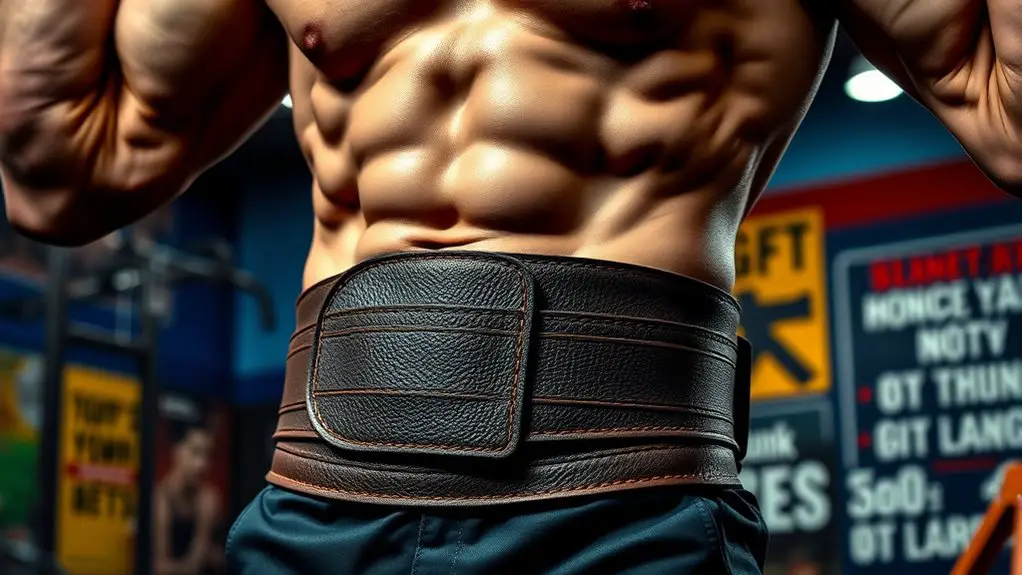Weightlifting belts help prevent injuries by stabilizing your spine and increasing intra-abdominal pressure during heavy lifts. This added support minimizes the risk of strains and sprains, especially in your lower back. They also enhance your lifting technique, promoting better spinal alignment and core engagement. While they're great for heavy lifts, remember to use them wisely. If you want to discover more about how to maximize your lifting safety, there's plenty more to explore.
The Science Behind Weightlifting Belts
When you lift heavy weights, using a weightlifting belt can greatly impact your performance and safety. These belts serve as a supportive tool, helping to stabilize your spine during intense lifts. By creating intra-abdominal pressure, a belt helps to maintain proper alignment, reducing the risk of injury. It's like having a strong brace around your core, giving you the confidence to push your limits without fear.
The science behind weightlifting belts lies in their ability to enhance your body's natural mechanics. When you engage in heavy lifting, your core muscles need to work harder to protect your spine. A belt aids this process, allowing you to lift more weight safely. It's not about relying solely on the belt, but rather using it as a part of your strategy to unleash your full potential. With the right technique and equipment, you can embrace the freedom to lift heavier and achieve your goals. Incorporating squats and deadlifts into your routine can further enhance your strength and stability.
Enhanced Core Stability and Support
A weightlifting belt can considerably enhance your core stability and support during heavy lifts. When you wear a belt, it increases intra-abdominal pressure, which helps stabilize your spine and pelvis. This added support allows you to lift heavier weights more safely, giving you the freedom to push your limits without the constant worry of injury. Additionally, a strong core is essential for reducing injury risk during intense physical activities.
Here's a quick look at the benefits:
| Benefit | Description |
|---|---|
| Increased Intra-Abdominal Pressure | Provides stability to your spine, reducing injury risk. |
| Improved Posture | Encourages proper alignment, enhancing overall lift quality. |
| Enhanced Performance | Supports heavier lifts, allowing you to achieve personal bests. |
| Reduced Fatigue | Minimizes strain on the core, helping you maintain energy. |
| Boosted Confidence | Gives you the mental edge to tackle challenging weights. |
Improved Lifting Technique
Using a weightlifting belt can greatly improve your lifting technique, particularly during complex movements. When you strap on a belt, it helps you engage your core more effectively, allowing for better spinal alignment. This enhanced stability means you can focus on executing each lift with precision, rather than worrying about maintaining balance or form.
With the added support, you're more likely to maintain a neutral spine, which can translate into lifting heavier weights with confidence. You'll find that your body naturally adopts a more efficient movement pattern, whether you're squatting, deadlifting, or performing overhead lifts. Additionally, a belt can help you develop core stability and strength, which is vital for overall performance in functional strength training.
As you improve your lifting technique, you'll also discover that your overall performance can enhance, giving you the freedom to push your limits. So, don't underestimate the power of a simple belt; it's not just a tool but a means to elevate your training experience and maximize your potential.
Risk Reduction for Common Injuries
While weightlifting belts aren't a cure-all, they can greatly reduce the risk of common injuries associated with heavy lifting. When you're lifting heavy weights, your core needs all the support it can get. A weightlifting belt helps stabilize your spine, allowing you to maintain proper alignment and form. This added support can greatly lower the chances of strains and sprains, particularly in your lower back and abdominal muscles.
In addition, a belt can enhance your intra-abdominal pressure, which protects your spine during those intense lifts. When your core's engaged, you've got a better shot at avoiding injuries that could sideline you. By incorporating a belt into your routine, you're not just lifting; you're lifting smart. You'll feel more confident tackling heavier loads, all while minimizing your risk of injury. Embrace that freedom to push your limits, knowing you've got an extra layer of protection. Additionally, strengthening exercises for knee stability can further support overall joint health during weightlifting activities.
When and How to Use Weightlifting Belts
Knowing when and how to use weightlifting belts can enhance their effectiveness in injury prevention. First, wear a belt during heavy lifts that challenge your core, like squats, deadlifts, or overhead presses. If you're lifting near your max, a belt can help stabilize your spine and support your lower back.
Second, put the belt on snugly but not overly tight; it should allow you to breathe freely while providing support. Remember, it's not a crutch—use it to compliment your core strength, not replace it.
Lastly, don't forget to take it off during lighter lifts or warm-ups. This way, you keep your core engaged and strengthen it without the belt's assistance. By using a weightlifting belt wisely, you'll enjoy the freedom to push your limits while minimizing injury risk.
Frequently Asked Questions
Can Beginners Use Weightlifting Belts Effectively?
Absolutely, you can use weightlifting belts effectively as a beginner. They can provide support and stability, helping you focus on form. Just remember, they shouldn't replace proper technique or gradual progression in your training.
Do Weightlifting Belts Work for All Types of Lifts?
Weightlifting belts can enhance stability during major lifts like squats and deadlifts, but they're not always necessary for lighter or isolation exercises. It's all about finding what works best for your unique lifting style.
How Tight Should a Weightlifting Belt Be?
Your weightlifting belt should be snug but not overly tight. You should be able to breathe comfortably and perform your lifts without restriction. Adjust it to guarantee support without compromising your movement or comfort.
Are There Any Downsides to Using Weightlifting Belts?
Sure, weightlifting belts can be great, but they might create a dependency. If you rely solely on them, you could neglect core strength development. Balance is key; don't let a belt limit your freedom in training.
Can I Rely Solely on a Belt for Injury Prevention?
You can't rely solely on a belt for injury prevention. While it supports your core, proper technique, strength training, and conditioning are essential for overall safety and performance. Balance is key to staying injury-free.




